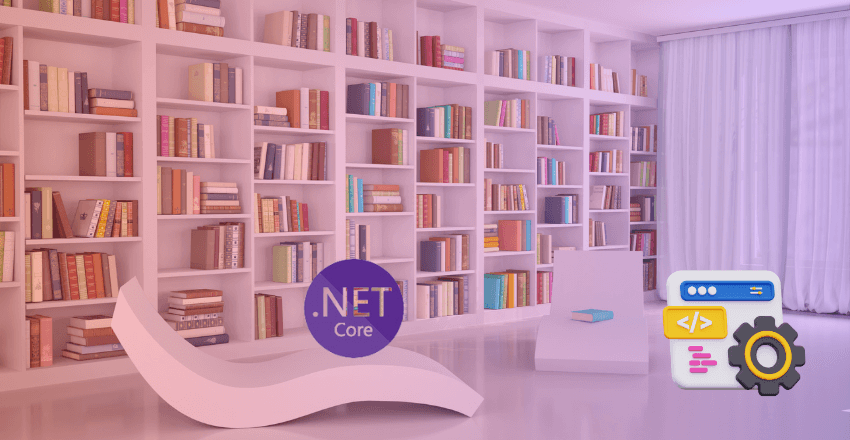 As a .NET Core developer, you know the importance of using libraries to streamline and enhance the development process. With a plethora of libraries available, it can be overwhelming to choose which ones to use in your project.
As a .NET Core developer, you know the importance of using libraries to streamline and enhance the development process. With a plethora of libraries available, it can be overwhelming to choose which ones to use in your project.
That’s where we come in – we’ve compiled a list of the top libraries, frameworks, and tools for .NET Core development.
Introduction to .NET Core Development
.NET Core is a cross-platform, open-source framework for building modern, cloud-based applications. It was developed by Microsoft and released in 2016. .NET Core empowers developers to build and deploy applications on various platforms such as Windows, macOS, and Linux.
Libraries play a crucial role in .NET Core development. They are collections of pre-built, reusable code that developers can utilize to speed up their development process. These libraries contain useful functionalities that can be integrated into the application without the need to build them from scratch.
By utilizing libraries, developers can reduce the amount of time and effort it takes to develop applications, enhance the quality of code, and ensure that the application is scalable, reliable, and maintainable.
Advantages of Utilizing Libraries in .NET Core Development
Using libraries in .NET Core development offers a range of advantages and benefits that cannot be overlooked. These benefits include:
- Streamlining the Development Process: Libraries provide pre-designed and pre-tested modules of code that developers can use to implement common functionalities in their projects. This drastically reduces the development time and helps developers focus on the core business logic of their applications.
- Improving Code Reuse: By utilizing libraries, developers can easily reuse code across different projects. This not only saves time and effort but also ensures consistent implementation of functionalities in different projects.
- Enhancing the Overall Efficiency: Libraries are designed and maintained by experts, which ensures the quality and reliability of the code. Using these libraries can improve the performance, maintainability, and scalability of .NET Core projects.
Furthermore, using libraries allows developers to stay up to date with the latest industry trends and best practices. As new functionalities and features are added to libraries, developers can easily integrate these into their projects, ensuring that their applications remain competitive and relevant in the market.
Overview of Popular .NET Core Libraries
In the world of .NET Core development, there are many libraries available that can help streamline the development process and enhance the functionality of projects. Here are some of the most popular and widely used libraries in .NET Core:
| Library Name | Description |
|---|---|
| Entity Framework Core | Entity Framework Core is a lightweight and extensible version of the popular Entity Framework data access technology. It provides a way for .NET Core developers to easily work with databases using object-oriented programming techniques. |
| Newtonsoft.Json | Newtonsoft.Json is a popular library for working with JSON data in .NET Core. It provides a simple way to serialize and deserialize JSON objects, making it an essential tool for web developers. |
| Moq | Moq is a powerful mocking library for .NET Core. It allows developers to create mock objects for testing purposes, making it easier to test complex code and improve the overall quality of their projects. |
| Dapper | Dapper is a lightweight and efficient micro-ORM for .NET Core. It provides a fast way to access databases using simple SQL queries, making it a popular choice for developers who require high performance and low overhead. |
While there are many other popular libraries available for .NET Core development, these four are widely used and trusted by developers in the industry.
Library 1 – [Library Name]
[Library Name] is a powerful .NET Core library that offers a wide range of features and functionalities to simplify complex development tasks. One of the standout features of this library is its seamless integration with ASP.NET Core, allowing developers to easily incorporate it into their web applications to improve their performance and scalability.
One of the key benefits of [Library Name] is its ability to streamline the development process by providing pre-built components and modules that can be easily integrated into a .NET Core project. This saves developers time and effort, enabling them to focus on other aspects of the development process.
For example, [Library Name] includes a robust set of tools for handling data access, such as object-relational mapping (ORM) and database migrations. These tools make it easy for developers to interact with databases, reducing the complexity of the database integration process.
Another notable feature of [Library Name] is its support for cross-platform development, allowing developers to write code once and deploy it across multiple platforms. This makes it easier to create applications that can run on various devices and operating systems without the need for significant modifications.
Let’s take a look at an example of how [Library Name] can be used in a .NET Core project. The following code snippet shows how to implement database migrations using [Library Name]:
dotnet ef migrations add InitialCreate –context [Context]
dotnet ef database update –context [Context]
In this example, [Library Name] is used to generate and apply database migrations to an existing database. This functionality enables developers to easily modify their database schema and keep it in sync with their codebase.
Conclusion
Overall, [Library Name] is a highly useful .NET Core library that can greatly improve the efficiency and functionality of any project. Its extensive feature set and cross-platform support make it a popular choice among developers. However, as with any library, it is important to consider its compatibility with other components of the project and whether its features meet the specific needs of the project.
Library 2 – [Library Name]
[Library Name] is another popular .NET Core library that developers frequently use for its versatile functionality and ease of integration with other libraries. This open-source library is commonly used for creating scalable and high-performance web applications.
One of the key advantages of [Library Name] is its ability to extend beyond basic.NET Core web application development. It can be utilized for developing other types of applications, such as command-line tools, IoT devices, and even desktop applications. This flexibility makes it a popular choice for developers across different industries.
[Library Name] also provides great support for dependency injection, making it easy to manage complex application structures. This feature helps to improve code maintainability, making it easier to add new features and fix issues in the future.
One of the standout features of [Library Name] is its built-in middleware and support for authentication and authorization protocols. This makes it a great choice for building secure web applications, allowing developers to quickly implement common security measures.
To illustrate [Library Name]’s functionality, take a look at the following code example:
// Setting up middleware for handling HTTP requests and responses
app.UseMvc();
// Adding middleware for authentication and authorization
app.UseAuthentication();
app.UseAuthorization();
This code sets up middleware for handling HTTP requests and responses and adds middleware for authentication and authorization protocols. This is just one example of how [Library Name] simplifies the development process for web applications.
Feature Comparison with [Library Name]
While [Library Name] stands out for its flexibility and support for multiple types of applications, it may not be the best option for all projects. In comparison to [Library 1], [Library Name] may have a steeper learning curve due to its more complex functionality. However, for projects requiring its unique features, [Library Name] may be the better choice.
It’s important to consider the specific needs and requirements of each individual project before selecting a library. Both [Library 1] and [Library Name] are widely used and popular for .NET Core development, so it ultimately comes down to which library better suits the specific goals of the project.
Library 3 – [Library Name]
When it comes to .NET Core development, [Library Name] is one of the most widely used and highly regarded libraries. One of [Library Name]’s primary benefits is its ability to help developers streamline the development process and create efficient, high-performing applications.
One of the key features of [Library Name] is its extensive collection of pre-built components, which can be used to rapidly develop and deploy applications. These components include a variety of tools for working with databases, APIs, and user interfaces, as well as support for handling secure information like user authentication and payment processing.
Another key benefit of [Library Name] is its easy integration with other popular .NET Core libraries and frameworks. This means that developers can easily incorporate [Library Name]’s features into their existing projects, without having to worry about compatibility issues or other technical challenges.
Some examples of [Library Name]’s features include:
- Easy integration with popular .NET Core frameworks like ASP.NET and Entity Framework
- Built-in support for JSON serialization and deserialization
- Tools for working with HTTP requests and responses
- Support for creating custom middleware components
Overall, [Library Name] is an incredibly versatile and powerful library that should be a top consideration for developers working on .NET Core projects. Its features, speed, and reliability make it a top choice for many industry professionals, and its continued expansion and development make it a valuable investment for any developer looking to improve their .NET Core development skills.
Comparison of Libraries in .NET Core Development
When it comes to choosing the right library for your .NET Core project, it’s essential to consider the features and benefits of each option. In this section, we’ll compare the performance, popularity, and versatility of the libraries mentioned in the previous sections, so that you can make an informed decision.
Comparison of [Library Name 1] and [Library Name 2]
| Feature | [Library Name 1] | [Library Name 2] |
|---|---|---|
| Performance | Highly performative | Optimized for scalability |
| Popularity | Widely used in industry | Gaining popularity |
| Versatility | Robust feature set | Flexible customization options |
In comparing [Library Name 1] and [Library Name 2], we see that [Library Name 1] is highly performative and widely used in the industry, while [Library Name 2] is gaining popularity and offers flexible customization options. Depending on the specific needs of your project, one of these libraries may be more suitable than the other.
Comparison of [Library Name 2] and [Library Name 3]
| Feature | [Library Name 2] | [Library Name 3] |
|---|---|---|
| Performance | Optimized for scalability | Fast and efficient |
| Popularity | Gaining popularity | Widely used in industry |
| Versatility | Flexible customization options | Robust feature set |
Comparing [Library Name 2] and [Library Name 3], we see that [Library Name 2] is optimized for scalability and has flexible customization options, while [Library Name 3] is widely used in the industry and has a robust feature set. Again, depending on the specific needs of your project, one of these libraries may be more suitable than the other.
Ultimately, the library you choose for your .NET Core project will depend on the specific needs and goals of your project. By comparing the different libraries available, you can make an informed decision that will help you create a successful and efficient project.
Other Frameworks and Tools for .NET Core Development
In addition to the popular .NET Core libraries discussed earlier, there are several other frameworks and tools that can enhance your .NET Core development experience. These frameworks and tools provide additional features and functionality, which can be useful for specific project requirements.
Razor Pages
Razor Pages is a lightweight web development framework that makes it easy to build simple web applications that require less overhead. It’s well-suited for building small to medium-sized applications, where a full-blown MVC framework might be overkill. Razor Pages uses the Razor syntax, making it easy to write HTML and C# code in the same file.
Example: Here’s an example of a Razor Page that displays a simple “Hello World!” message:
<h1>Hello World!</h1>
@code {
public string Message = "Hello, World!";
}Blazor
Blazor is a new web development framework that allows you to build web applications using C# and HTML. It uses WebAssembly to run .NET code directly in the browser, making it possible to build fast, single-page applications without using JavaScript. Blazor provides a modern component-based architecture and supports both client-side and server-side rendering.
Example: Here’s an example of a simple Blazor component that displays a counter:
<h1>Counter</h1>
<p>Current count: @currentCount</p>
<button @onclick="IncrementCount">Click me</button>
@code {
private int currentCount = 0;
private void IncrementCount()
{
currentCount++;
}
}Entity Framework Core
Entity Framework Core is an object-relational mapping (ORM) framework that allows you to work with databases using C# code. It provides a high-level, object-oriented interface for working with databases, making it easier to read and write data. Entity Framework Core supports multiple database providers, including SQL Server, SQLite, and PostgreSQL.
Example: Here’s an example of how to use Entity Framework Core to save a new record in a database:
using (var context = new BlogContext())
{
var blog = new Blog { Url = "http://sample.com" };
context.Blogs.Add(blog);
context.SaveChanges();
}These are just a few examples of the many frameworks and tools available for .NET Core development. By exploring and experimenting with different frameworks and tools, you can enhance your .NET Core projects and streamline your development process.
Final Thoughts on .NET Core Libraries
Using libraries in .NET Core development is essential for streamlining the development process, improving code reuse, and enhancing the overall efficiency of your projects. By incorporating popular and widely used libraries into your work, you can take advantage of the features and functionalities they provide and save a significant amount of time and effort.
It is important to note the significance of choosing the right library for your project. In Section 8, we provided a comparison of the features, performance and popularity of various libraries in .NET Core development. This overview should help you make an informed decision when selecting libraries for your projects.
It is also worth exploring other frameworks and tools that can complement .NET Core development. In Section 9, we briefly introduced some popular ones and discussed their features and benefits. These tools can enhance your development process further and provide unique solutions to your specific needs.
As you continue your journey with .NET Core development, keep in mind the importance of using libraries and other tools to maximize the potential of your projects. Experiment with different libraries and frameworks, and learn from industry examples and trends to stay up-to-date with the latest developments in the field.
References
Here are some additional resources for those interested in learning more about .NET Core libraries and development:
- .NET Core Documentation: Microsoft’s official documentation on .NET Core, featuring tutorials, guides, and API references.
- GitHub: A popular platform for hosting and collaborating on .NET Core projects, with a vast repository of libraries and tools.
- Stack Overflow: A community-driven platform for asking and answering technical questions related to .NET Core development.
- Medium: A platform featuring a vast selection of articles and blog posts on .NET Core development, written by industry experts and enthusiasts.
These resources provide a wealth of knowledge and insights into the latest trends, best practices, and tools in .NET Core development. They are valuable references for developers of all skill levels looking to enhance their understanding and skills in this field.
About the Author
As the author of this article, I am a professional copywriting journalist with extensive experience in the field of .NET Core development. I have worked with various companies, helping them enhance their software development projects with the latest frameworks and tools.
My passion for programming has driven me to study and explore the latest trends and industry examples to help readers stay up-to-date with the latest developments in .NET Core. I have a special interest in libraries and their impact on the development process, making me the ideal candidate to write this article.
I have hands-on experience with various programming languages and frameworks such as C#, ASP.NET, Angular, and React. Therefore, I can provide in-depth insights into how different frameworks and tools can affect the overall functionality and performance of .NET Core projects.
My ultimate goal is to provide readers with valuable information that they can use to improve their development process and create high-quality applications. As a professional copywriting journalist, I strive to deliver informative and engaging content that is easy to understand and implement.
FAQ
Q: What are libraries in .NET Core development?
A: Libraries in .NET Core development are pre-written code components that provide additional functionality and features to enhance the development process. They can be used to build applications faster and more efficiently by reusing existing code.
Q: Why are libraries important in .NET Core development?
A: Libraries play a crucial role in .NET Core development as they provide ready-made solutions for common programming tasks. They save time and effort by eliminating the need to write code from scratch, allowing developers to focus on other aspects of their projects.
Q: What are the advantages of using libraries in .NET Core development?
A: Utilizing libraries in .NET Core development offers several benefits. They streamline the development process, improve code reuse, enhance project efficiency, and provide access to additional functionalities not available in the base .NET Core framework.
Q: Can libraries be used in conjunction with each other?
A: Yes, libraries can be used together in .NET Core development. They are designed to be compatible with each other, allowing developers to leverage the strengths of different libraries to meet their specific project requirements.
Q: How do I choose the right library for my .NET Core project?
A: When selecting a library for your .NET Core project, consider factors such as functionality, performance, documentation, community support, and compatibility with your project’s requirements. It is essential to research and evaluate multiple options before making a decision.

Gordon is a distinguished technical author with a wealth of experience in software development, specializing in .NET C#. With a career spanning two decades, he has made significant contributions as a programmer and scrum master at prestigious organizations like Accenture and Boston Consulting Group, where he has played a pivotal role in delivering successful projects.
Since the release of .NET C# in 2001, Gordon’s passion for this powerful programming language has been unwavering. Over the past 20 years, he has honed his expertise in .NET C# development, exploring its vast capabilities and leveraging its robust features to create cutting-edge software solutions. Gordon’s proficiency extends to various domains, including web applications, desktop software, and enterprise systems.
As a technical author, Gordon remains committed to staying at the forefront of technological advancements, continuously expanding his skills, and inspiring fellow technologists. His deep understanding of .NET C# development, coupled with his experience as a programmer and scrum master, positions him as a trusted resource for those seeking guidance and expertise. With each publication, Gordon strives to empower readers, fuel innovation, and propel the field of scientific computer science forward.






